Key takeaways:
- Student feedback sessions are essential for fostering improvement in teaching methods and creating a trusting learning environment.
- Different types of feedback sessions, such as focus groups and anonymous surveys, reveal diverse insights and encourage open communication.
- Active listening and the use of open-ended questions can enhance the quality of feedback obtained from students.
- Implementing feedback leads to a more engaging classroom atmosphere and empowers students by involving them in decision-making.
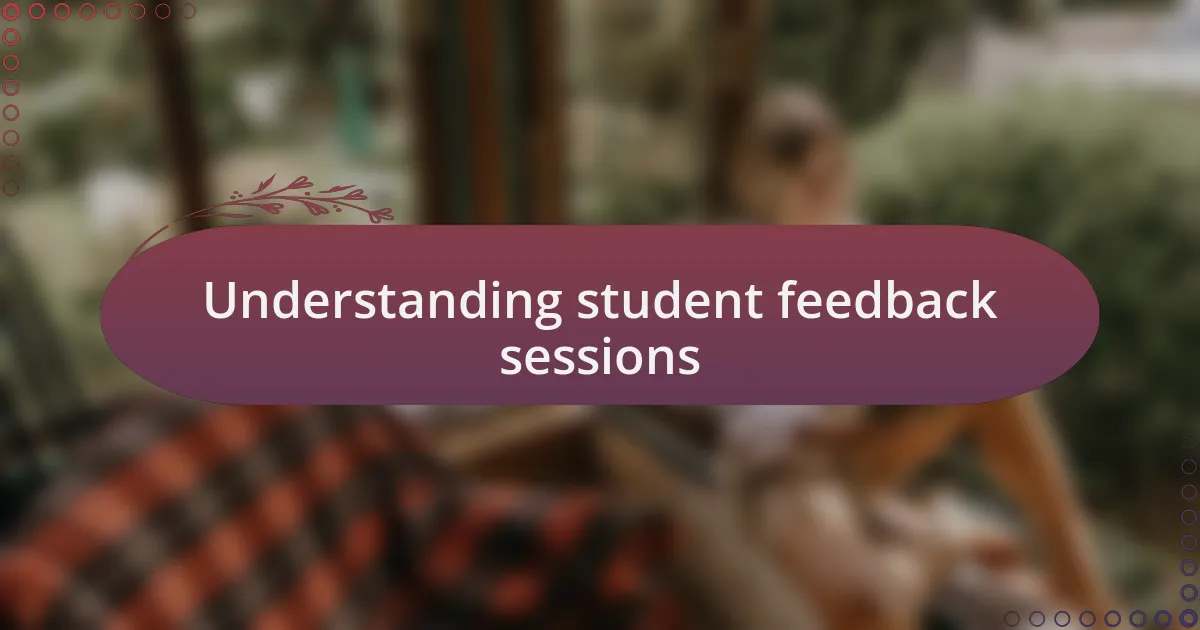
Understanding student feedback sessions
Student feedback sessions are a vital tool for understanding the learning environment. I recall the first time I held one; the candid remarks surprised me. It was a wake-up call to realize just how much students yearn to share their experiences and thoughts—don’t you think their insights can reshape our teaching methods?
These sessions often reveal underlying issues that might not otherwise surface in regular interactions. For instance, a student once mentioned feeling lost in the course material, which prompted me to rethink my teaching approach. This feedback not only fostered improvement in my methods but also deepened my connection with students, making me wonder—how often do we overlook their voices?
When we genuinely listen during these feedback sessions, we create a space for dialogue and trust. One memorable moment was when a quiet student finally spoke up, sharing her struggles with group work. It struck me how powerful it is to encourage vulnerability, as it not only enriches the learning experience but also reminds me of my own educational journey—how I wished for a safe space to express my thoughts and feelings.

Importance of student feedback
Collecting student feedback is crucial because it offers a direct line to their thoughts and feelings about the learning process. I remember a time when a student’s suggestion about the pace of the lessons made me realize that what feels comfortable to me might be overwhelming for others. Have you ever paused to consider how a simple tweak in approach could drastically enhance a student’s experience?
Moreover, feedback provides an opportunity for growth—not just for students, but for educators as well. I find it rewarding to reflect on constructive criticism; it often leads to innovative teaching strategies I hadn’t considered before. It begs the question: how can we truly improve if we don’t invite our students to guide us on this journey?
Embracing feedback also cultivates a culture of respect and collaboration. One year, a group of students initiated a feedback forum that transformed our classroom atmosphere. It was empowering to witness their active ownership of their learning, reinforcing the idea that their voices are instrumental in shaping a dynamic educational environment. Don’t you think that open communication can bridge gaps and pave the way for meaningful relationships in education?
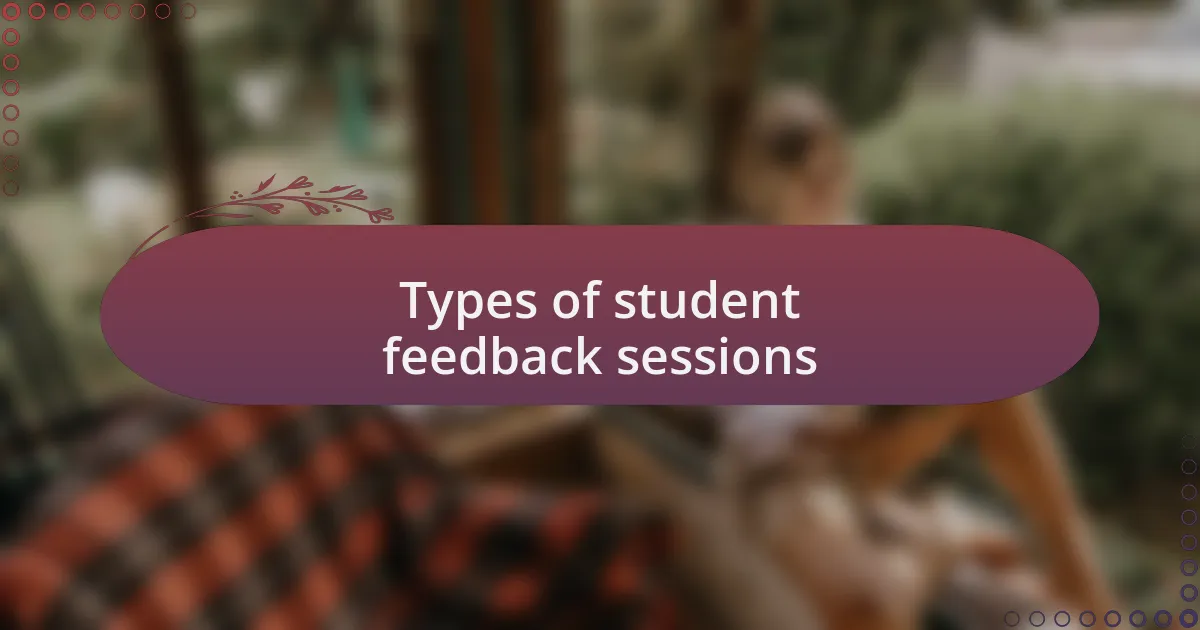
Types of student feedback sessions
When it comes to student feedback sessions, there are several types to consider, each serving a unique purpose. I’ve found that focus groups can be particularly enlightening, as they allow a small group of students to engage in deeper discussions about their learning experiences. I remember a session where a few students voiced their struggles with group projects, sparking a conversation that led to changes in how we approached collaborative assignments. Isn’t it fascinating how a simple gathering can unearth so many insights?
Surveys and questionnaires are another popular type of feedback session. I often distribute them at the end of a course because they’re a quick way to gather a broad spectrum of opinions. One time, the anonymous nature of these surveys revealed concerns some students had about course materials that they might not have voiced otherwise. It made me question whether anonymity empowers students to be more honest about their experiences—what do you think?
Lastly, individual feedback sessions provide an intimate setting for students to share their thoughts. I recall an instance with a shy student who opened up during one-on-one discussions, revealing her fears about public speaking. This personal connection not only built her confidence but also highlighted how tailored feedback can foster individual growth. It’s clear to me that every type of feedback session has its own strengths, and each contributes to a richer understanding of the student experience.
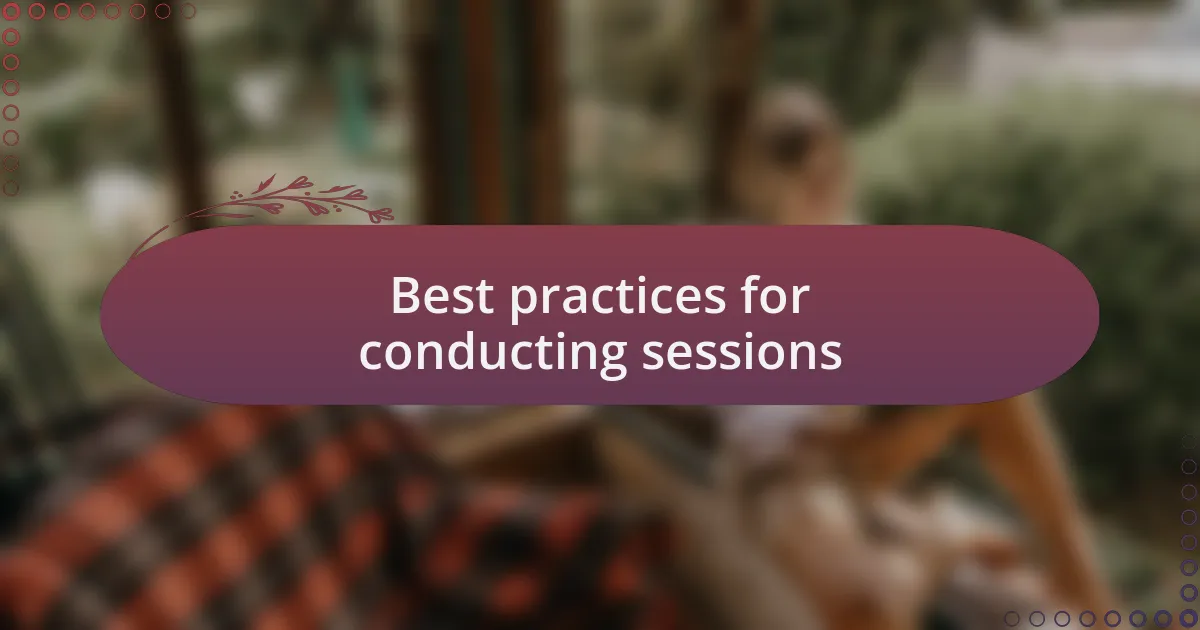
Best practices for conducting sessions
Creating a welcoming environment is crucial when conducting feedback sessions. I’ve noticed that when students feel safe and valued, they’re more likely to share their honest thoughts. One time, I began a session with a simple icebreaker, allowing students to express something positive about their learning experience. This shifted the atmosphere dramatically, making everyone feel more comfortable to voice their concerns. What can I say? A little warmth can go a long way!
It’s essential to ask open-ended questions that encourage reflection and elaboration. Rather than simply seeking ‘yes’ or ‘no’ answers, I often prompt students with, “What challenges did you face this semester?” This technique not only stimulates conversation but also reveals deeper insights into their learning processes. I recall a session where an open question led to a rich discussion about the pacing of the curriculum, ultimately influencing how I structured future classes. How can we leverage these moments of clarity to enhance our educational practices?
Listening actively is perhaps the most critical practice in these sessions. I make it a point to paraphrase what students share, which not only shows that I’m paying attention but also invites them to clarify or expand on their thoughts. Once, during a conversation about resource accessibility, a student mentioned feeling overwhelmed by the variety of materials available. By acknowledging their concerns and asking follow-up questions, we identified the need for a more streamlined resource guide. In that moment, it became clear: true listening fosters a collaborative learning environment where students feel acknowledged and empowered.
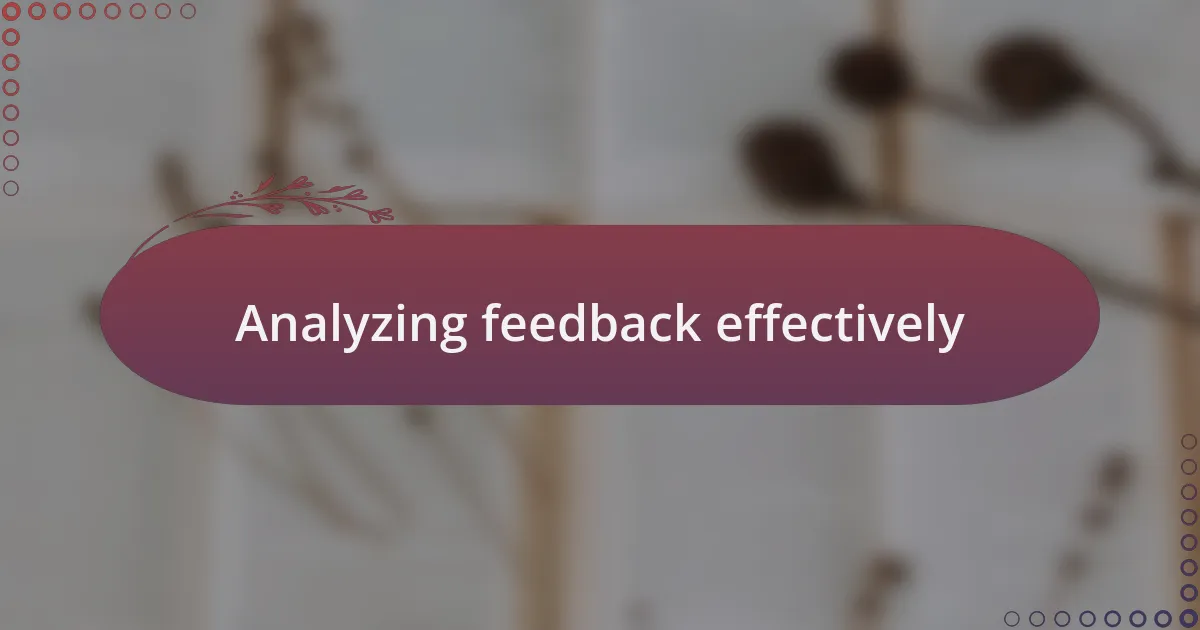
Analyzing feedback effectively
Analyzing feedback effectively requires a genuine commitment to understanding the nuances behind students’ responses. I often find myself reflecting on specific comments made during feedback sessions, searching for underlying themes. For instance, when several students suggested there was too much homework, I didn’t just take it at face value. Instead, I considered their perspectives and explored whether their workload might be contributing to their overall stress levels. How often do we overlook the emotional context behind feedback?
Sometimes, I create a simple chart to prioritize feedback, categorizing comments into actionable insights and general observations. This method allows me to visualize trends across multiple sessions. I remember a time when I noticed a pattern concerning the difficulty of assessments; by highlighting this, I was able to address it with my colleagues. It’s fascinating how visual tools can clarify complex information and guide our decision-making.
Ultimately, I believe it’s essential to follow up after analyzing feedback. Once, after making adjustments based on students’ concerns about course materials, I reached out to them asking if they noticed any improvements. The responses I received buoyed my spirits—students appreciated the changes, which reinforced the importance of continuing this dialogue. This iterative process turns feedback into a powerful tool for growth. Are we not all striving for an educational experience that responds to our needs?
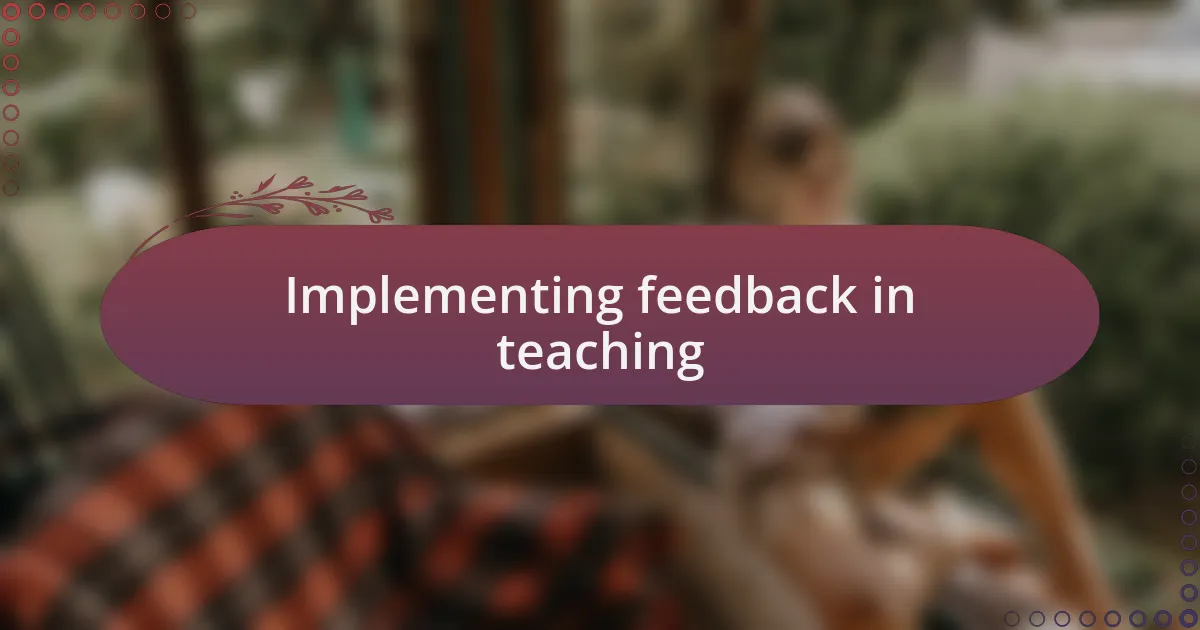
Implementing feedback in teaching
Implementing student feedback in teaching involves more than just making adjustments; it’s about transforming the learning environment. One time, after receiving comments about my pacing during lectures, I decided to consciously slow down and incorporate more pauses for questions. The change not only fostered an engaging atmosphere but also made students feel more comfortable voicing their thoughts. It raises an intriguing question: what if we dedicated more time to listen and adapt in real-time?
I also learned the value of involving students in the decision-making process. During a discussion about group projects, I asked students to suggest changes they felt could improve collaboration. The suggestions that emerged not only reflected their insights but also deepened their investment in the class. It’s eye-opening to think about the transformative power of shared ownership—how might our classrooms evolve if we saw students as partners in education?
What truly surprised me was the positive ripple effect of implementing feedback. After making specific changes to my assessment strategies based on student input, I noticed an increase in engagement and performance. I remember a student confiding that my willingness to adapt made her feel respected and valued. That moment made me ponder the real connection between student voice and motivation. Are we not enhancing the educational experience when we embrace the thoughts and feelings of those we teach?
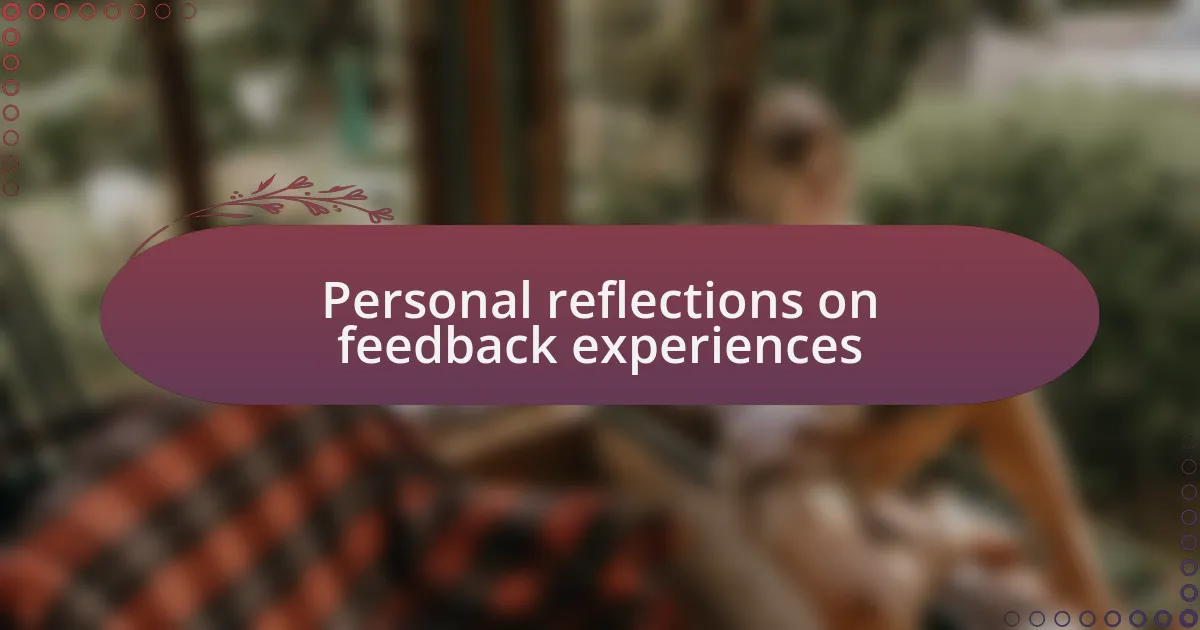
Personal reflections on feedback experiences
Reflecting on my experiences with student feedback sessions, I recall a particularly candid moment when a student mentioned feeling overwhelmed by the volume of material covered. It struck me how vulnerable students can be in sharing their struggles, highlighting their need for understanding in an academic environment. I couldn’t help but wonder: how often do we truly pause to consider the emotional weight our teaching methods may carry for our students?
In another feedback session, a student shared that my enthusiasm for a subject didn’t always translate into their engagement. Initially, I felt caught off guard, but that vulnerability opened my eyes to the importance of connecting content with their interests. It made me think about how critical it is to tailor our teaching approach. Are we genuinely aligning our presentations with our students’ passions, or are we merely projecting our own excitement?
These feedback experiences revealed a layer of responsibility I hadn’t fully grasped before. I remember a student who expressed gratitude for my openness to change, stating it empowered them to voice their own ideas. This made me reflect on the significance of fostering a safe space where students feel their opinions matter. How can we continue to nurture that kind of environment? It’s an ongoing journey of mutual respect and growth, don’t you think?